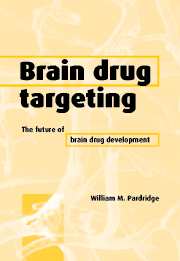Book contents
- Frontmatter
- Contents
- Preface
- List of abbreviations
- 1 Drug targeting, drug discovery, and brain drug development
- 2 Invasive brain drug delivery
- 3 Lipid-mediated transport and carrier-mediated transport of small molecules
- 4 Receptor-mediated transcytosis of peptides
- 5 Vector discovery: genetically engineered Trojan horses for drug targeting
- 6 Linker strategies: the engineering of multifunctional drug formulations
- 7 Protein neurotherapeutics and peptide radiopharmaceuticals
- 8 Antisense neurotherapeutics and imaging gene expression in vivo
- 9 Gene therapy of the brain
- 10 Blood–brain barrier genomics
- References
- Index
- Plate section
6 - Linker strategies: the engineering of multifunctional drug formulations
Published online by Cambridge University Press: 08 January 2010
- Frontmatter
- Contents
- Preface
- List of abbreviations
- 1 Drug targeting, drug discovery, and brain drug development
- 2 Invasive brain drug delivery
- 3 Lipid-mediated transport and carrier-mediated transport of small molecules
- 4 Receptor-mediated transcytosis of peptides
- 5 Vector discovery: genetically engineered Trojan horses for drug targeting
- 6 Linker strategies: the engineering of multifunctional drug formulations
- 7 Protein neurotherapeutics and peptide radiopharmaceuticals
- 8 Antisense neurotherapeutics and imaging gene expression in vivo
- 9 Gene therapy of the brain
- 10 Blood–brain barrier genomics
- References
- Index
- Plate section
Summary
Introduction
Chimeric peptides are multifunctional drug formulations. Therefore, in linking a drug to a transport vector, it is essential that the bifunctionality of the conjugate be retained. This can be achieved in one of two ways. First, the drug and vector may be conjugated via a noncleavable (amide) linker in such a way that the biological activity of both components is retained. Second, the drug and vector may be conjugated via a cleavable (disulfide) linker, and the biologic activity of the drug may be lost when the drug is in the form of the chimeric peptide. However, the biologic tivity of the drug may be restored following cleavage of the drug from the conjugate. Therefore, there are multiple approaches to the creation of multifunctional chimeric peptides and the diversity of the molecular formulations is outlined in Figure 6.1.
The construction of a chimeric peptide starts from three separate platforms that must be given simultaneous consideration. First, a vector discovery program must be initiated for the discovery of species-specific blood–brain barrier (BBB) transport vectors, such as those reviewed in Chapters 4 and 5. Second, the linker strategy must be developed and this might use chemical conjugates, genetically engineered fusion proteins, avidin-biotin technology, pegylation technology, or liposome technology (Figure 6.1). The linker strategy may employ cleavable linkers such as disulfides, or noncleavable linkers such as amides or thioethers. Within the noncleavable amide linker category, the linker may be short, e.g., 14–20 atoms, or extended, e.g., >200 atoms in length. The third area that must be considered is the pharmacokinetics and metabolic stability of the conjugate in vivo.
- Type
- Chapter
- Information
- Brain Drug TargetingThe Future of Brain Drug Development, pp. 155 - 185Publisher: Cambridge University PressPrint publication year: 2001



